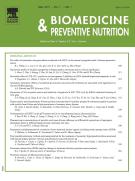Valproic acid attenuates blood pressure, vascular remodeling and modulates ET-1 expression in L-NAME induced hypertensive rats - 30/05/14
 , Jeganathan Manivannan, Thangarasu Silambarasan
, Jeganathan Manivannan, Thangarasu SilambarasanAbstract |
The present study was considered to assess the antihypertensive and antioxidant effect of valproic acid, against Nω- nitro-L arginine methyl ester hydrochloride (L-NAME) induced hypertension in male Wistar rats. Hypertension was prompted in adult male albino rats of the Wistar strain, weighing 180–220g, by oral administration of the L-NAME (40mg/kg body weight/day) in drinking water for 4 weeks. The L- NAME hypertensive rats revealed significant (P<0.05) rise in the systolic and diastolic blood pressure, heart rate, water intake and heart weight L-NAME hypertensive rats also revealed significant (P<0.05) increase in the levels of thiobarbituric acid reactive substances, lipid hydroperoxides in plasma and tissues (heart and aorta), and significant (P<0.05) drop in the body weight, nitrite and nitrate levels in plasma and aorta. Activities of enzymic antioxidants such as superoxide dismutase, catalase and glutathione peroxidase in erythrocyte and tissues and the levels of non-enzymic antioxidant such as reduced glutathione in plasma and tissues, ET-1 mRNA expression in aorta was significantly (P<0.05) increased in L-NAME rats. Valproic acid (VPA) supplementation (100mg/kg) daily for four weeks brought back all the above parameters to near normal level. The above outcomes were confirmed by the histopathological examination. No significant (P<0.05) effect was observed in control rats treated with valproic acid (100mg/kg). These results suggest that valproic acid performed as an antihypertensive and antioxidant agent against L-NAME induced hypertension.
Le texte complet de cet article est disponible en PDF.Keywords : L-NAME, Oxidative stress, Antioxidant, Valproic acid, Endothelin-1
Plan
Vol 4 - N° 2
P. 195-202 - avril 2014 Retour au numéroBienvenue sur EM-consulte, la référence des professionnels de santé.
L’accès au texte intégral de cet article nécessite un abonnement.
Déjà abonné à cette revue ?

